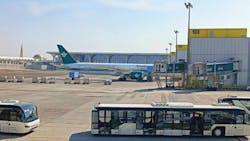Ground Support in the Middle East: An Industry at a Crossroads
The Middle East aviation sector stands in an advantaged position, driven by national visions, strategic geographical positioning, and infrastructure investments that are reshaping the aviation landscape.
As the region emerges as a critical bridge between East and West, its airports have become important nodes in the international travel network, necessitating an evolution in ground handling services to meet growing demands.
Saudi Arabia’s Vision 2030 and the UAE’s continued focus on aviation excellence exemplify the region’s commitment to becoming a world-leading aviation hub. This transformation extends beyond passenger terminals and runways, it is demanding sophisticated, technology-driven ground handling operations capable of supporting current and estimated growth trajectories.
The convergence of several key factors is driving this transformation: rapidly expanding flight operations, increasing passenger expectations for seamless travel experiences, environmental sustainability mandates, and the need for operational efficiency in an increasingly competitive market. Ground handling companies are responding with substantial investments in electrification, automation, digital technologies, and workforce development programs that align with regional economic diversification goals. This evolution signifies a strategic repositioning of the Middle East as a cornerstone of global aviation infrastructure.
Ground handling services and airport growth
Dirk Goovaerts, Swissport’s CEO, Continental Europe, Middle East, Africa & India and global cargo chair, affirms that the ground handling sector in the Middle East, particularly in Saudi Arabia, is on a strong upward trajectory, in line with the ambitious expansion of the region’s aviation sector and Saudi Vision 2030.
“Saudi airports saw a 15% increase in passenger traffic in 2024, reaching 128 million travelers, with growth expected to continue through 2030. We have responded decisively, expanding to 13 airports across the Kingdom starting in June 2025, increasing flight handling capacity by more than 50% compared to 2024.
"Key hubs driving this growth include Riyadh (King Khalid International), Jeddah (King Abdulaziz International), Medina, and Dammam, as well as rapidly growing regional airports such as Hail, Al Jouf, Tabuk, Yanbu, Taif, Abha, and Jizan," he says. “This expansion positions us as a strategic enabler for airline and airport growth, directly supporting Saudi Arabia’s vision of becoming a world-leading aviation hub."
dnata continues to experience strong demand from airline partners, driven by Dubai’s continued growth as a key destination for business and leisure travel, according to Jaffar Dawood, divisional senior vice president, UAE airport operations at dnata.
“As we expand operations, we are focused on developing our team and improving operational efficiency to ensure the continued delivery of high-quality services to our customers at both Dubai airports. We are proud to actively contribute our experience and expertise to the development of the new Al Maktoum Airport, one of the industry’s most significant global infrastructure projects," he says.
“This mega-project allows us to offer world-class services, based on the latest technologies and innovative design. We are excited about what lies ahead and proud to operate in a country with visionary leaders who recognize the aviation sector as a key driver of national growth and success."
Ground handling technologies, infrastructure, and investments
Swissport is active in ground handling innovation across the Middle East by introducing advanced digital and sustainable technologies, according to Goovaerts.
“A key focus is the electrification of ground support equipment (eGSE), combined with intelligent fleet management systems and digital tools that improve safety, reduce emissions, and enhance efficiency. Building on global pilot projects, including autonomous vehicle trials and real-time data platforms, we are now introducing these solutions in the Middle East, ensuring regional operations benefit from proven innovation," he says.
“Return on investment is realized through lower fuel and maintenance costs, improved asset availability, and increased service reliability. These technological investments not only improve service levels for airlines but also support regional sustainability goals aligned with Saudi Vision 2030."
In 2025, Swissport completed one of the fastest expansions in its history, entering seven new Saudi airports in just 40 days prior to its June launch, Goovaerts observes. “This required the rapid deployment of full GSE fleets and the training of over 400 employees to ensure service readiness from day one. Investments continue to focus on the expansion and modernization of ground support equipment fleets, with a focus on electrification, supported by dedicated facilities for fleet management and maintenance. In addition to ramp services, Swissport is also preparing to introduce additional offerings such as cargo handling, aircraft cleaning, and lounge operations to provide end-to-end solutions," he says.
“These investments are being made in close collaboration with local stakeholders and partners, including GACA and ASYAD Holding Group, and are aligned with the infrastructure development goals of Saudi Vision 2030."
A fleet of six electric, autonomous baggage handling tractors was recently deployed at Dubai World Central - Al Maktoum International (DWC) airport, Dawood affirms.
“While autonomous vehicles have largely been limited to trials, this deployment introduces the technology into normal daily operations. As global travel continues to recover and operational demands increase, automation could be key to building smarter, safer, and more resilient infrastructure. This next-generation technology will significantly improve workforce productivity and reduce safety risks," he says.
“A key strength is our continued investment in electric equipment and our broader commitment to reducing emissions across all operations. In addition to expanding our electric fleet, a key milestone was the transition of all non-electric GSE to biodiesel at both Dubai airports, a key step in our sustainability journey."
Job market conditions and training programs
The ground handling sector in the Middle East faces a highly competitive labor market, with rising salary expectations and increasing service levels from airlines, according to Goovaerts.
“Swissport addresses these challenges by investing in robust training and development programs, tailored to regional needs while leveraging global best practices. During the recent expansion of the Saudi airports, over 400 new employees were trained in just a few weeks, supported by digital learning platforms and on-the-job coaching," he says.
“Local recruitment is a key priority, ensuring we contribute to the development of the national workforce while ensuring world-class operational standards. This approach directly supports the human capital development goals of the Saudi Vision 2030 by creating jobs, transferring skills, and developing local expertise. Thanks to a culture of safety, continuous learning, and digital transformation, we are positioning as an employer of choice in the aviation sector."
dnata is actively recruiting and training new staff across all locations, Dawood affirms. “We offer highly competitive salaries, solid benefits, and a robust career development program supported by our in-house training facilities. We are confident that, thanks to our industry-leading offering and attractive employer branding, we will continue to be a leading employer in the region," he says.
Summing up
The Middle East ground handling sector is undergoing substantial structural changes as companies respond to increased traffic volumes and infrastructure development. The operational expansions being experienced demonstrate the sector’s capacity to scale rapidly when market conditions require it. Technology implementation, including e-GSE, reflects the industry’s response to operational demands. The transition from trial phases to operational deployment indicates increasing confidence in these technologies.
The sector’s current trajectory aligns with regional aviation development plans. Sustainability requirements embedded in national development visions will likely influence equipment procurement decisions and operational practices going forward.
The approaches being implemented in the Middle East may inform industry practices in other high-growth aviation markets, particularly regarding rapid scaling methodologies and technology integration timelines.
About the Author

Mario Pierobon
Dr. Mario Pierobon provides solutions in the areas of documentation, training and consulting to organizations operating in safety-sensitive industries. He has conducted a doctoral research project investigating aircraft ground handling safety. He may be reached at [email protected].
